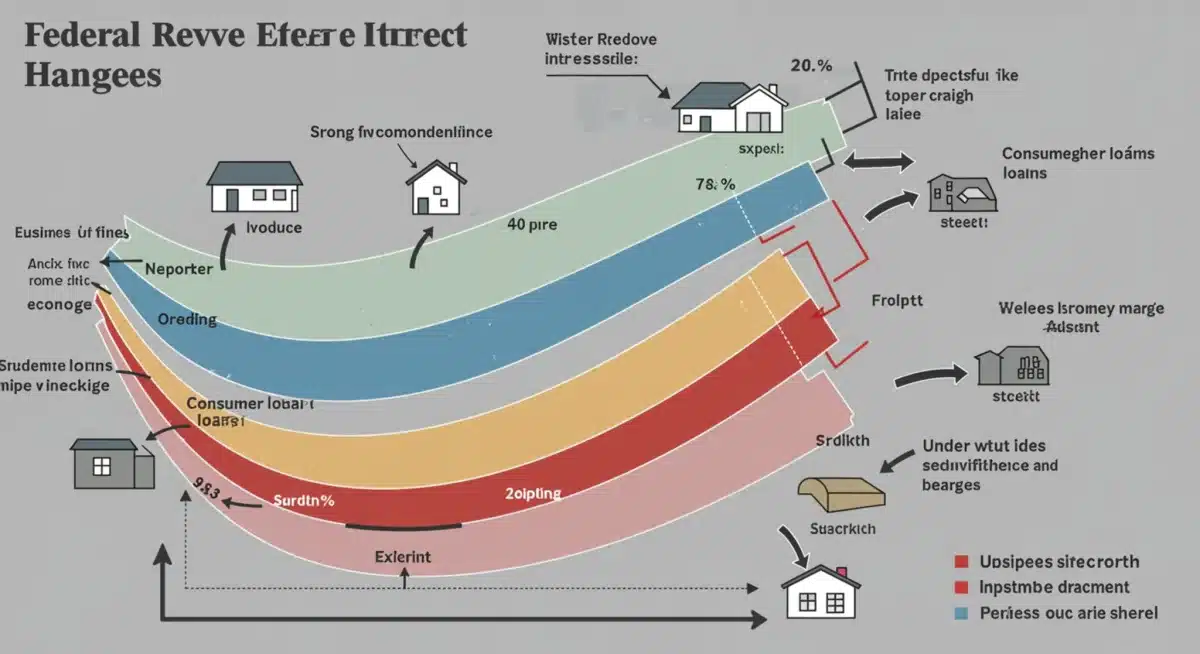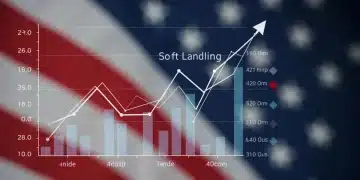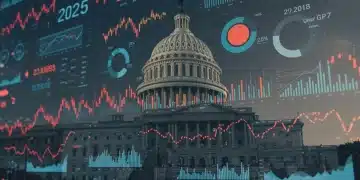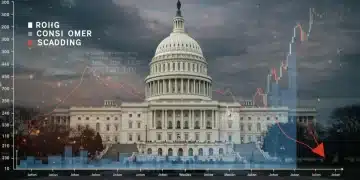Fed Interest Rate Adjustments: Economic Effects Explained

The Federal Reserve’s recent adjustments to interest rates serve as a primary mechanism to curb inflation and stabilize the U.S. economy, directly affecting borrowing costs, consumer spending, and investment across various sectors.
Understanding the new Federal Reserve interest rate adjustments and their economic effects is crucial for anyone navigating the current financial landscape. These changes, often perceived as technical maneuvers by central bankers, actually ripple through every aspect of our daily economic lives, from the interest on your mortgage to the performance of your retirement savings. Let’s delve into what these adjustments mean for you and the broader U.S. economy.
The Federal Reserve’s Role in Monetary Policy
The Federal Reserve, often referred to as the Fed, is the central banking system of the United States. Its primary responsibilities include conducting the nation’s monetary policy, supervising and regulating banking institutions, maintaining the stability of the financial system, and providing financial services to depository institutions, the U.S. government, and foreign official institutions. One of its most powerful tools for influencing the economy is the adjustment of the federal funds rate.
Monetary policy, at its core, involves managing the supply of money and credit in the economy. The Fed uses various tools to achieve its dual mandate: maximizing employment and maintaining price stability (i.e., controlling inflation). When the economy is overheating and inflation is high, the Fed typically raises interest rates to cool down economic activity. Conversely, during economic downturns, it lowers rates to stimulate growth. These actions have profound implications for businesses, consumers, and investors alike.
Understanding the Federal Funds Rate
- Definition: The federal funds rate is the target interest rate set by the Federal Open Market Committee (FOMC) at which commercial banks borrow and lend their excess reserves to each other overnight.
- Mechanism: While the Fed doesn’t directly control the rate banks charge consumers, changes to the federal funds rate influence other interest rates throughout the economy, including those for loans, mortgages, and savings accounts.
- Impact: A higher federal funds rate generally leads to higher borrowing costs for everyone, discouraging spending and investment, which can help tame inflation. A lower rate does the opposite, making borrowing cheaper and encouraging economic activity.
The Fed’s decisions are not made in a vacuum; they are the result of careful analysis of economic data, including inflation rates, employment figures, and GDP growth. The goal is always to strike a balance that promotes sustainable economic growth without triggering excessive inflation or a recession. The transparency of the Fed’s communication is also vital, as market participants react not only to actual rate changes but also to expectations of future changes.
Impact on Inflation and Consumer Spending
One of the most direct and intended consequences of Federal Reserve interest rate adjustments is their effect on inflation and consumer spending. When the Fed raises rates, it makes borrowing more expensive across the board. This directly impacts consumers by increasing the cost of loans, such as mortgages, auto loans, and credit card debt, which in turn tends to reduce their purchasing power and willingness to spend.
Higher interest rates also incentivize saving. When banks offer better returns on savings accounts and certificates of deposit, consumers are more likely to save their money rather than spend it. This reduction in aggregate demand is a key mechanism through which the Fed aims to bring down inflation. Less money chasing the same goods and services often leads to slower price increases, eventually helping to stabilize the cost of living.
How Higher Rates Curb Inflation
- Reduced Borrowing: Higher rates make new loans more expensive, deterring individuals and businesses from taking on new debt.
- Increased Savings: Attractive returns on savings accounts encourage consumers to save more and spend less.
- Decreased Demand: A reduction in overall spending and investment helps to cool down an overheated economy, easing inflationary pressures.
- Stronger Dollar: Higher interest rates can attract foreign investment, strengthening the dollar, which makes imports cheaper and further helps to reduce inflation.
Conversely, when the Fed lowers rates, it attempts to stimulate consumer spending and investment. Cheaper borrowing costs make it more attractive for people to take out loans for big purchases, like homes and cars, and for businesses to expand. This increased demand can boost economic activity, but if not managed carefully, it can also lead to inflationary pressures if supply cannot keep up with demand. The delicate balance required in these decisions underscores the complexity of monetary policy.
Effects on Borrowing Costs and Mortgage Rates
The Federal Reserve’s interest rate adjustments have a swift and significant impact on borrowing costs throughout the economy, with mortgage rates being one of the most visible examples for the average American. When the Fed increases its benchmark rate, the cost of borrowing for banks also rises. These higher costs are then passed on to consumers in the form of higher interest rates on various loans, including home mortgages.
For prospective homebuyers, this means that monthly mortgage payments become more expensive, potentially pricing some individuals out of the market or forcing them to opt for smaller homes. Existing homeowners with adjustable-rate mortgages (ARMs) may also see their monthly payments increase, adding financial strain. The housing market is particularly sensitive to these changes, as even a small increase in interest rates can significantly affect affordability and demand.

Key Areas Affected by Higher Borrowing Costs
Higher interest rates extend beyond mortgages, influencing a wide range of financial products:
- Auto Loans: The cost to finance a new or used car increases, potentially leading to higher monthly payments or longer loan terms.
- Credit Card Rates: Most credit card interest rates are variable and directly tied to the prime rate, which moves in tandem with the federal funds rate. This means higher costs for carrying a balance.
- Business Loans: Companies face higher borrowing costs for expansion, inventory, and operational expenses, which can impact investment decisions and hiring.
- Student Loans: While federal student loan rates are set annually, private student loan rates can be affected by changes in the federal funds rate, particularly for variable-rate loans.
The cumulative effect of these increased borrowing costs is a slowdown in economic activity. Consumers and businesses become more cautious about taking on new debt, leading to reduced spending and investment. This is precisely the Fed’s intention when it aims to cool down an overheated economy and bring inflation under control. Understanding these connections helps individuals and businesses make informed financial decisions in response to the Fed’s actions.
Impact on Investment and Financial Markets
The Federal Reserve’s interest rate adjustments send significant signals through financial markets, profoundly influencing investment decisions, stock market performance, and the valuation of various assets. When the Fed raises interest rates, it generally makes riskier assets, such as stocks, less attractive compared to safer investments like bonds. This is because higher interest rates mean that bonds offer better returns, drawing money away from equities.
Furthermore, higher borrowing costs for businesses can reduce their profitability, as their expenses for debt servicing increase. This can lead to lower earnings forecasts, which often translates to a decline in stock prices. Growth stocks, in particular, which rely heavily on future earnings potential, tend to be more vulnerable to rising interest rates because their future cash flows are discounted at a higher rate, reducing their present value.
How Rate Hikes Affect Different Investments
- Stocks: Generally see downward pressure as borrowing costs rise and future earnings are discounted more heavily.
- Bonds: New bonds issued after a rate hike offer higher yields, making them more attractive. Existing bonds may see their prices fall as their fixed, lower yields become less competitive.
- Real Estate: Higher mortgage rates can cool the housing market, impacting real estate investment trusts (REITs) and property values.
- Savings Accounts and CDs: These typically offer higher interest rates, making them more appealing for conservative savers.
On the other hand, when the Fed lowers interest rates, the opposite effects tend to occur. Stocks become more attractive as borrowing costs decrease for businesses, potentially boosting corporate profits and encouraging expansion. Bond yields fall, making equities relatively more appealing. These market dynamics highlight the intricate relationship between monetary policy and investor behavior, requiring careful consideration from market participants.
Global Economic Repercussions
The Federal Reserve’s interest rate adjustments do not operate in isolation; they send ripples across the global economy. Given the U.S. dollar’s role as the world’s primary reserve currency and the size of the American economy, changes in U.S. monetary policy have significant international implications. When the Fed raises interest rates, it typically strengthens the U.S. dollar. This occurs because higher rates make dollar-denominated assets, like U.S. government bonds, more attractive to foreign investors seeking better returns, increasing demand for the dollar.
A stronger dollar has a mixed impact globally. For countries that import goods from the U.S. or whose debts are denominated in dollars, a stronger dollar makes these more expensive. This can increase their import costs and the burden of servicing their dollar-denominated debt, potentially straining their economies. Emerging markets, in particular, can be vulnerable to these shifts, as capital may flow out of their economies and into the U.S. in search of higher returns, leading to currency depreciation and financial instability in those nations.

International Economic Impacts of Fed Rate Hikes
- Currency Fluctuations: A stronger dollar can weaken other currencies, affecting international trade balances and competitiveness.
- Capital Flows: Money tends to flow towards higher-yielding assets, potentially drawing capital away from other countries, especially emerging markets.
- Debt Burden: Countries and companies with dollar-denominated debt face higher repayment costs when the dollar strengthens.
- Commodity Prices: Many commodities, like oil, are priced in dollars. A stronger dollar can make these commodities more expensive for countries using weaker currencies.
Conversely, a weaker dollar, often resulting from lower U.S. interest rates, can make U.S. exports more competitive and ease the debt burden for foreign entities. These global repercussions underscore the interconnectedness of the world economy and the far-reaching influence of the Federal Reserve’s monetary policy decisions, requiring other central banks and governments to often adjust their own policies in response.
Preparing for Future Rate Changes
Given the significant and multifaceted impact of Federal Reserve interest rate adjustments, understanding how to prepare for future changes is essential for both individuals and businesses. The Fed typically communicates its intentions and economic outlook through various channels, including FOMC statements, press conferences, and speeches by Fed officials. Paying attention to these communications can provide valuable insights into the likely direction of monetary policy.
For individuals, this could mean considering refinancing a mortgage to a fixed-rate loan if rates are expected to rise, or consolidating high-interest debt. For businesses, it involves assessing the impact of rising borrowing costs on investment plans, cash flow, and overall profitability. Proactive financial planning, rather than reactive measures, can help mitigate the negative effects and even capitalize on opportunities presented by changing rate environments.
Strategies for Individuals and Businesses
Here are some key strategies to consider:
- Review Debt: Evaluate existing debt, especially variable-rate loans. Consider paying down high-interest debt or refinancing to fixed rates if appropriate.
- Build Savings: Higher interest rates can make savings accounts more attractive. Building an emergency fund becomes even more beneficial.
- Assess Investments: Re-evaluate investment portfolios. Consider diversifying or adjusting allocations based on the potential impact of rate changes on different asset classes.
- Budgeting: Adjust personal and business budgets to account for potentially higher borrowing costs and changes in purchasing power.
- Stay Informed: Continuously monitor economic indicators and Federal Reserve communications to anticipate future policy shifts.
The economic landscape is dynamic, and the Federal Reserve’s role in guiding it is paramount. By understanding the mechanisms and effects of interest rate adjustments, individuals and businesses can make more informed decisions, fostering greater financial resilience and stability in an ever-evolving economic climate. Predicting the exact timing and magnitude of future rate changes is challenging, but being prepared for various scenarios is always a prudent approach.
Historical Context and Future Outlook
To truly grasp the significance of current Federal Reserve interest rate adjustments, it is beneficial to look at their historical context and consider the potential future outlook. The Fed has a long history of using interest rates to manage economic cycles, from combating the high inflation of the 1970s to stimulating growth during the 2008 financial crisis and the COVID-19 pandemic. Each period presents unique challenges, and the Fed’s responses are always tailored to the prevailing economic conditions.
In recent history, the period following the 2008 crisis saw an extended period of near-zero interest rates, designed to foster recovery. More recently, as inflation surged post-pandemic, the Fed embarked on an aggressive series of rate hikes to bring price stability back. These historical patterns demonstrate the Fed’s commitment to its dual mandate and highlight the cyclical nature of monetary policy in response to economic pressures.
Lessons from Past Rate Cycles
- Inflation Control: Aggressive rate hikes have historically been effective in bringing down persistent inflation, though often at the risk of slowing economic growth.
- Stimulating Growth: Lowering rates can effectively stimulate borrowing and investment during downturns, but can also lead to asset bubbles if maintained for too long.
- Market Reaction: Financial markets often anticipate Fed actions, and their reactions can sometimes amplify or mitigate the intended effects of policy changes.
- Unintended Consequences: Monetary policy can have unforeseen impacts on various sectors, necessitating careful monitoring and potential adjustments.
Looking ahead, the future outlook for interest rates will largely depend on the trajectory of inflation, the strength of the labor market, and broader economic growth. The Fed aims for a ‘soft landing,’ where inflation is brought under control without triggering a severe recession. However, achieving this balance is a complex task, and the path forward is rarely smooth. Market participants, economists, and the public will continue to closely watch economic data and Fed communications for clues about future policy directions, as these decisions will shape the economic environment for years to come.
| Key Aspect | Economic Effect |
|---|---|
| Inflation Control | Higher rates reduce aggregate demand, slowing price increases. |
| Borrowing Costs | Mortgages, auto loans, and credit card rates tend to increase. |
| Investment Climate | Stocks may face pressure, while bonds become more attractive. |
| Global Impact | Strengthens the U.S. dollar, affecting international trade and debt. |
Frequently Asked Questions About Fed Interest Rates
The primary goal is to achieve the Fed’s dual mandate: maximizing employment and maintaining price stability. By adjusting interest rates, the Fed aims to either stimulate economic growth during downturns or curb inflation during periods of overheating, ensuring a balanced and stable economy.
Higher interest rates typically lead to increased mortgage costs. For new homebuyers, this means higher monthly payments. Existing homeowners with adjustable-rate mortgages (ARMs) may also see their rates and payments rise, impacting affordability and potentially slowing the housing market.
Yes, most credit card interest rates are variable and directly tied to the prime rate, which closely follows the federal funds rate. Therefore, when the Fed raises its benchmark rate, credit card interest rates typically increase, making it more expensive to carry a balance.
Higher interest rates generally put downward pressure on stock prices. This is because borrowing costs for companies increase, affecting profitability, and safer investments like bonds become more attractive, drawing capital away from equities. Lower rates tend to have the opposite effect.
U.S. rate hikes often strengthen the dollar, making dollar-denominated goods and debts more expensive for other countries. This can lead to capital outflows from emerging markets, currency depreciation in other nations, and increased debt burdens for entities with dollar-denominated loans.
Conclusion
The Federal Reserve’s interest rate adjustments are a powerful and indispensable tool for managing the U.S. economy, with far-reaching implications that extend from individual household budgets to global financial markets. Understanding the new Federal Reserve interest rate adjustments and their economic effects is not merely an academic exercise; it is crucial for navigating the complexities of modern finance. These policy decisions directly influence inflation, borrowing costs, investment opportunities, and international economic stability. By staying informed about the Fed’s strategies and the underlying economic indicators, individuals and businesses can make more informed decisions, fostering greater financial resilience and stability in an ever-evolving economic climate. The ongoing effort to balance growth with price stability remains a cornerstone of the Fed’s mission, shaping the financial realities for all.





